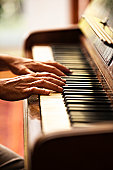
Home > Styles of Music > Classical Piano
|
|
Learn How to Play Classical Piano(Scroll down to see the full list of lessons in this section)
A wide sets of skills is required, including thematic expansion, repeated motifs, altering these motifs and proper procedure of notation. These qualifications will allow you to represent a composer’s intention. Pieces of classical music have been written in order to include novices; however beginners should be warned that this is not a simple genre to play. If at first you do not succeed, do not be frightened to revisit classical piano music later in life. Classical music was first used in order to distinguish great piano masters in Europe between 1750 and early 20th century. The term was first used in order to group men like Bach and Beethoven together within one genre. It is challenging to create a list detailing historical period, styles, forms and genres specifically designed for classical practice due to the wide variety of subgroups. You will be required to learn the differences between each group if you are serious in learning the complexities of classical piano music. Classical music includes a multitude of musical genres. They are very different once compared against each other and possess a variety of different elements and styles. Unfortunately, many individuals are unable to clearly identify the differences between subdivisions. It is important to identify the differences in classical piano genres to fully appreciate and understand its value. The list provided below will aid in your ability to distinguish the different styles of classical piano. Piano Concerto
Solo Piano This subgroup is divided into 8 different genres: ballade, prelude, scherzo, waltz, etude, mazurka, polonaise, and nocturne. Many great pianists have composed amazing solo piano pieces, including Chopin and Rachmaninoff. Ballads possess strong narrative components within a large-scale movement. Preludes are often thought to be a work of improvisation due to its short and internal form. Scherzos are usually cheerful. Waltzes denote folk dances in ¾ time. Etudes are used for instruction of specific skills. Mazurkas are cheery Polish folk dances composed in a triple meter. Polonaises are a slow Polish dance conducted at ¾ time. Nocturnes are pieces of music which have been inspired by the night. Piano Sonata Sonatas are often unaccompanied constructions of three to four movements. The most notable piano sonatas belong to Chopin and Beethoven. Piano Trio The trio is one of the most popular forms in chamber music. They are delivered with a piano and two accompanying instruments. Piano Quintet A Quintet is very similar to the trio; however there are four other instruments additional to the piano.
Classical Piano Lessons Listing:
| |
|
Although every attempt has been made to make information as accurate as possible, we are not responsible for any errors that may appear.
 Classical piano playing is often admired by other pianists and you are now
ready to enter this great adventure for yourself. First, you must understand that playing classic music is
based on a variety of different intricate piano skills and is not a simple genre to master.
Classical piano playing is often admired by other pianists and you are now
ready to enter this great adventure for yourself. First, you must understand that playing classic music is
based on a variety of different intricate piano skills and is not a simple genre to master.
 Piano concertos are pieces of music which are created by soloist, small groups, or
orchestras. Piano becomes the most important piece of music and contrasts the other musical instruments. They
are often divided into three movements; beginning with a fast pace, turning into a slow pace which is then
returned to a fast pace.
Piano concertos are pieces of music which are created by soloist, small groups, or
orchestras. Piano becomes the most important piece of music and contrasts the other musical instruments. They
are often divided into three movements; beginning with a fast pace, turning into a slow pace which is then
returned to a fast pace.



